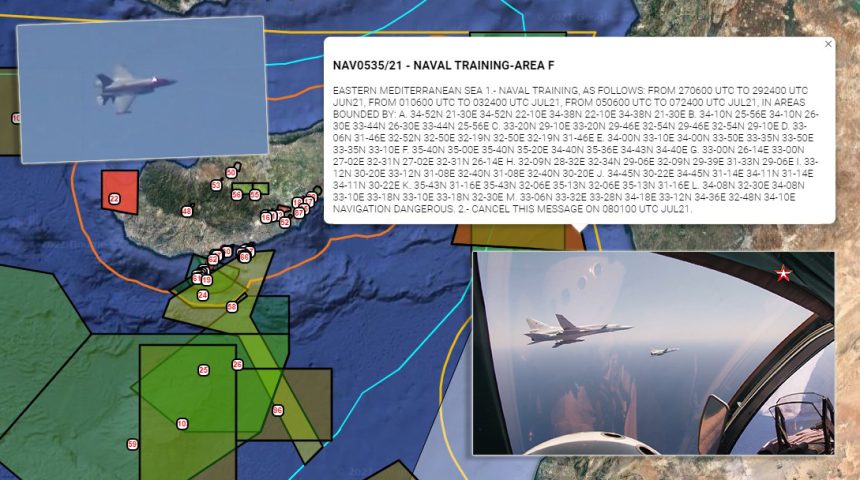A Russian exercise in the Eastern Mediterranean Sea, involving five warships as well as Tu- 142MK, Il-38, Tu-22M3 and MiG-31K aircraft, provided an opportunity for a close encounter with at least one F-35B operating from HMS Queen Elizabeth.
The Russian Aerospace Forces have kicked off an exercise in the eastern Mediterranean Sea on Jun. 25, 2021. As the Russian MOD announced in a public statement, five ships of the Russian Navy (the Moskva missile cruiser; the Admiral Essen and Admiral Makarov frigates, as well as two submarines, the Stary Oskol and Rostov-on-Don), together with Tu-142MK and Il-38 anti-submarine aircraft, Tu-22M3 Backfire bombers and MiG-31K aircraft are involved in the exercise, whose goal is to train combat forces to ensure the security of two key Russian bases in Syria: Khmeimim airbase and Tartus.
We’re about to see an interesting Russian exercise in the Mediterranean Sea. 2 MiG-31K, an Il-38 ASW aircraft, and at least 3 Tu-22M3 bombers have arrived at Kheimim airfield in Syria. This is the 1st deployment of MiG-31K and 2nd of Tu-22M3 to Syria.https://t.co/oMe4je0ycp pic.twitter.com/Zp8NHn81WB
— Rob Lee (@RALee85) June 25, 2021
At least two MiG-31K, an Il-38 ASW aircraft, and three Tu-22M3 bombers have arrived at Kheimim airfield in Syria, whose capabilities have been expanded with the extension of the runway and the completion of a second runway. These works, completed in May, have allowed Moscow to deploy its LRA (Long Range Aviation) bombers along with the missile-carrier aircraft to the airbase on the Mediterranean Sea and launch missions from there.
The Russian MOD told reporters on Jun. 28 that the MiG-31K armed with the air-launched Kinzhal (Dagger) hypersonic missile and Tu-22M3 bombers performed training flights escorted by Su-35 and Su-34 aircraft during the eastern Med drills.
“As part of the joint exercise, the crews of MiG-31K aircraft, capable of using the latest hypersonic missiles from the Kinzhal missile, and long-range Tu-22M3 bombers made regular training flights in the eastern Mediterranean Sea, during which they completed the tasks of mastering the air space in maritime zone”, said the Defense Ministry. Some simulated missile launches were carried out by the MiG-31s using the Kinzhal missile during exercises in the Mediterranean Sea, according to Interfax.
For some context, here’s what we wrote when the Russian Aerospace Forces conducted the first successful test firing of the Kinzhal in 2018:
Kinzhal is claimed to be a strategic air-to-surface strike missile. The missile is claimed to have maneuverable flight characteristics not typically seen in hypersonic, solid fuel missiles. Observers of Russian missile programs have voiced skepticism about Russia’ performance claims however. According to Russians and reference sources the Kinzhal missile has a top speed of Mach 10 and maintains some ability to maneuver throughout its performance envelope including at hypersonic speed. If accurate, these capabilities could make the Kinzhal difficult to intercept by anti-missile systems. The missile is reported to have a range of 1,200 miles (approximately 2,000 kilometers). This, added to the reported 1,860-mile unrefueled range of the MiG-31BM long range, supersonic interceptor, gives the Kinzhal potentially intercontinental strike capability. The missile is also reported to be nuclear-capable and able to hit ground as well as naval targets.
Footage released by the Russian MOD provides also some additional details. First of all, the Tu-22M3 flew with Kh-22 anti-ship cruise missiles in the video. Indeed, the Backfire was primarily developed as an anti-ship missile carrier for the Soviet/Russian supersonic Kh-22/32 anti-ship missiles with range of up to 1,000 km (621 miles) as well as for smaller Kh-15 missiles with range of up to 300 km (160 miles).
Interestingly, the HMS Queen Elizabeth is currently reportedly operating in the Med Sea, south of Cyprus. It seems quite likely that the Russian aircraft have carried out already (or will, in the next days) perform some simulated attack on the British aircraft carrier and her strike group. For sure, the proximity between the has already provided an opportunity for a close encounter, as proved by a video, also released on Jun. 28, showing an F-35B from HMS QE flying near Russian Admiral Makarov frigate.
As already explained, on her maiden operational deployment (dubbed CSG-21), HMS Queen Elizabeth, with F-35B jets belonging to both the Royal Air Force and the U.S. Marine Corps VMFA-211 Wake Island Avengers, based at MCAS (Marine Corps Air Station) Yuma, Arizona, is heading to the Indo-Pacific region as the flagship of the largest naval and air task force under British command since the Falklands war. However, as planned, before reaching the troubled waters of the South China Sea, the British aircraft carrier will supporting counter-Daesh operations in Iraq and Syria. During her stay in the Med, it’s quite likely the Russians will keep an eye on the British aircraft carrier group and viceversa.









